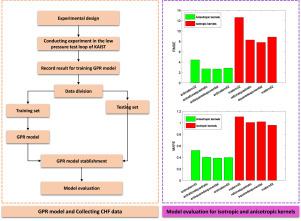当前位置:
X-MOL 学术
›
Eng. Appl. Artif. Intell.
›
论文详情
Our official English website, www.x-mol.net, welcomes your feedback! (Note: you will need to create a separate account there.)
Analyzing the effects of various isotropic and anisotropic kernels on critical heat flux prediction using Gaussian process regression
Engineering Applications of Artificial Intelligence ( IF 8 ) Pub Date : 2024-04-09 , DOI: 10.1016/j.engappai.2024.108351 Mandana Soleimani , Mohsen Esmaeilbeigi , Roberto Cavoretto , Alessandra De Rossi
Engineering Applications of Artificial Intelligence ( IF 8 ) Pub Date : 2024-04-09 , DOI: 10.1016/j.engappai.2024.108351 Mandana Soleimani , Mohsen Esmaeilbeigi , Roberto Cavoretto , Alessandra De Rossi

|
The critical heat flux (CHF) is an important parameter determining the heat transfer capability of nuclear reactors. Therefore, prediction of CHF with accuracy and correct understanding is essential for the design and safety analysis of nuclear power plants (NPPs) and industrial boiling systems. This paper focuses on the CHF prediction using the Gaussian process regression (GPR), a machine learning (ML) technique for modeling nonlinear systems. The covariance kernel is a critical component of GPR modeling because it contains assumptions about the function we want to know and defines the dependence and similarity between the data. In this study, the prediction of CHF is investigated during training and prediction in two different approaches: isotropic and anisotropic covariance kernels. Besides, we evaluate the influence of various isotropic and anisotropic kernels on the accuracy of CHF prediction and quantification of uncertainty encoded in the posterior variances in each of the approaches. The use of anisotropic kernels, considering different shape parameters in line with different data dimensions, results in higher accuracy and better generalization. In addition, compared to other ML tools such as support vector regression (SVR) and artificial neural networks (ANNs), the GPR with anisotropic kernels has much better performance. The evaluation criteria involving root mean square error (RMSE) and mean absolute percentage error (MAPE) in anisotropic kernels are significantly improved compared to isotropic kernels. For example, in squared exponential and rational quadratic kernels, RMSE and MAPE values improved by {65.81%, 67.28%} and {61.97%, 60.12%} values, respectively. The results of the GPR method with the anisotropic kernels show the relative superiority of this method compared to SVR and ANN. The lowest RMSE and MAPE values of all three methods were compared, and these values have improved in GPR compared to SVR by 96.01% and 94.25% and compared to ANN by 84.40% and 85.51%, respectively. Finally, some valuable ideas and practical findings will be offered based on numerical simulations and comparisons between isotropic and anisotropic kernel assumptions. Since the approach of using anisotropic kernels has high computational time despite its high flexibility, we will address this issue in future studies and also use this approach for other nuclear engineering problems.
中文翻译:

使用高斯过程回归分析各种各向同性和各向异性核对临界热通量预测的影响
临界热通量(CHF)是决定核反应堆传热能力的重要参数。因此,准确预测和正确理解 CHF 对于核电站 (NPP) 和工业沸腾系统的设计和安全分析至关重要。本文重点介绍使用高斯过程回归 (GPR) 进行 CHF 预测,高斯过程回归是一种用于建模非线性系统的机器学习 (ML) 技术。协方差核是 GPR 建模的关键组成部分,因为它包含有关我们想要知道的函数的假设,并定义数据之间的依赖性和相似性。在本研究中,在训练和预测期间采用两种不同的方法研究 CHF 的预测:各向同性和各向异性协方差核。此外,我们还评估了各种各向同性和各向异性核对 CHF 预测准确性的影响以及每种方法中后验方差编码的不确定性量化。使用各向异性核,根据不同的数据维度考虑不同的形状参数,可以获得更高的精度和更好的泛化能力。此外,与支持向量回归(SVR)和人工神经网络(ANN)等其他机器学习工具相比,具有各向异性核的 GPR 具有更好的性能。与各向同性核相比,各向异性核中涉及均方根误差(RMSE)和平均绝对百分比误差(MAPE)的评估标准显着改善。例如,在平方指数和有理二次核中,RMSE 和 MAPE 值分别提高了 {65.81%, 67.28%} 和 {61.97%, 60.12%} 值。具有各向异性核的 GPR 方法的结果表明该方法相对于 SVR 和 ANN 具有相对优越性。比较了所有三种方法的最低 RMSE 和 MAPE 值,这些值在 GPR 中比 SVR 分别提高了 96.01% 和 94.25%,与 ANN 相比分别提高了 84.40% 和 85.51%。最后,基于数值模拟以及各向同性和各向异性核假设之间的比较,将提供一些有价值的想法和实践结果。由于使用各向异性核的方法尽管具有很高的灵活性,但计算时间很长,我们将在未来的研究中解决这个问题,并将这种方法用于其他核工程问题。
更新日期:2024-04-09
中文翻译:

使用高斯过程回归分析各种各向同性和各向异性核对临界热通量预测的影响
临界热通量(CHF)是决定核反应堆传热能力的重要参数。因此,准确预测和正确理解 CHF 对于核电站 (NPP) 和工业沸腾系统的设计和安全分析至关重要。本文重点介绍使用高斯过程回归 (GPR) 进行 CHF 预测,高斯过程回归是一种用于建模非线性系统的机器学习 (ML) 技术。协方差核是 GPR 建模的关键组成部分,因为它包含有关我们想要知道的函数的假设,并定义数据之间的依赖性和相似性。在本研究中,在训练和预测期间采用两种不同的方法研究 CHF 的预测:各向同性和各向异性协方差核。此外,我们还评估了各种各向同性和各向异性核对 CHF 预测准确性的影响以及每种方法中后验方差编码的不确定性量化。使用各向异性核,根据不同的数据维度考虑不同的形状参数,可以获得更高的精度和更好的泛化能力。此外,与支持向量回归(SVR)和人工神经网络(ANN)等其他机器学习工具相比,具有各向异性核的 GPR 具有更好的性能。与各向同性核相比,各向异性核中涉及均方根误差(RMSE)和平均绝对百分比误差(MAPE)的评估标准显着改善。例如,在平方指数和有理二次核中,RMSE 和 MAPE 值分别提高了 {65.81%, 67.28%} 和 {61.97%, 60.12%} 值。具有各向异性核的 GPR 方法的结果表明该方法相对于 SVR 和 ANN 具有相对优越性。比较了所有三种方法的最低 RMSE 和 MAPE 值,这些值在 GPR 中比 SVR 分别提高了 96.01% 和 94.25%,与 ANN 相比分别提高了 84.40% 和 85.51%。最后,基于数值模拟以及各向同性和各向异性核假设之间的比较,将提供一些有价值的想法和实践结果。由于使用各向异性核的方法尽管具有很高的灵活性,但计算时间很长,我们将在未来的研究中解决这个问题,并将这种方法用于其他核工程问题。



























 京公网安备 11010802027423号
京公网安备 11010802027423号